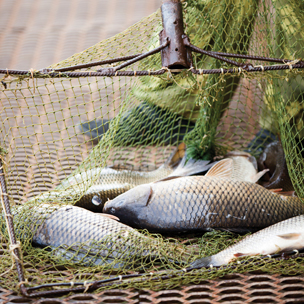August 1, 2014 — As writer Rowan Jacobsen explores in our recent feature “Has Meat Met Its Match?,” animal agriculture’s hefty environmental footprint is creating interest in exploring ways to meet humans’ growing appetite for animal protein that extend beyond beef, chicken and pork. In some places, that exploration is going underwater.
Aquaculture, or fish farming, is the fastest growing sector of animal food production in the world, providing half of all seafood consumed by humans. That number is expected to rise, with another 40 million tons of seafood needed by 2030 to meet demand.
Is a fish sandwich any better for the environment than a cheeseburger or pork tenderloin? It is more efficient from a feed perspective. Nine pounds of feed will produce around 7.5 pounds of salmon, a far better feed conversion ratio than those for cattle and swine. In addition, aquaponics — raising fish and edible plants in a single system in which fish wastes serve as plant food — is being hailed as a particularly efficient solution to the challenge of feeding a booming population.
It’s not all smooth sailing on the aquaculture seas, however. Organic wastes from aquaculture can foul waterways. Growing feed for fish farms already requires a land area the size of the United Kingdom, and harvesting wild species for fishmeal strains marine resources. And at the end of the day, critics argue that jam-packed fishponds aren’t much different than regular feedlots, requiring antibiotics, creating a genetic monoculture and polluting the surrounding landscape.
But, much like traditional agriculture, sustainable practices exist for aquaculture, including only cultivating nonnative species in fish tanks or using lower stock densities to prevent disease. When it comes to satisfying the world’s carnivorous cravings, aquaculture and aquaponics may be a few more tools to add to the sustainability toolbox.
Ensia shares solutions-focused stories free of charge through our online magazine and partner media. That means audiences around the world have ready access to stories that can — and do — help them shape a better future. If you value our work, please show your support today.
Yes, I'll support Ensia!
